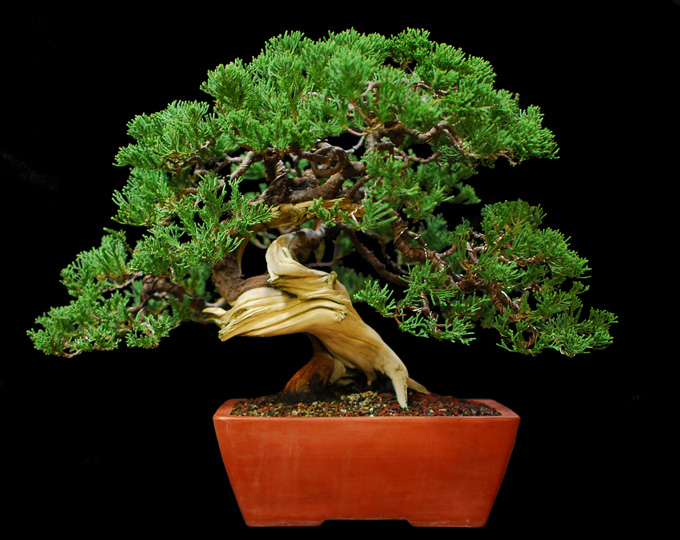 Unless you know the whole story (see below), you’d swear that this dynamic bonsai is an ancient yamadori (tree collected from the wild). But actually it’s a field grown Taiwanese juniper whose time on earth (so far) is measures in decades rather than centuries. The bonsai artist is the highly accomplished Mr Cheng, Cheng-Kung of Taiwan (you can see a spinning version on his website). The owner is Mr. Hsu,Lung-Fa.
Unless you know the whole story (see below), you’d swear that this dynamic bonsai is an ancient yamadori (tree collected from the wild). But actually it’s a field grown Taiwanese juniper whose time on earth (so far) is measures in decades rather than centuries. The bonsai artist is the highly accomplished Mr Cheng, Cheng-Kung of Taiwan (you can see a spinning version on his website). The owner is Mr. Hsu,Lung-Fa.
Though we have many friends and fellow bonsai lovers who to take the time and trouble to write comments, perhaps our favorite is Jose Luis Rodriquez. Jose Luis is a student of Cheng, Cheng-Kung and an authority on Taiwanese bonsai (and beyond) and the person who sets us (that’s me) straight with relentless objectivity, but always with patience and respect.
Enough said, it’s time for the inside story on Taiwanese juniper in Jose Luis’ own words (from a comment on a previous post):
“One thing I always like to stress when talking about Taiwanese Junipers is the fact that they are NOT collected trees. With very few exceptions, one hundred percent of Taiwanese juniper bonsai come from field grown stock.
Many people have seen pictures of the Taiwanese high mountain junipers in Hualien (Taroko National Park). Having seen these, there is often the misconception that perhaps some of the famous Taiwan juniper bonsai have been collected from these mountains. Fortunately, I am glad to say no.
The natural Juniperus squamata, var. tarokoensis are illegal to collect and will not survive the lower altitudes where the vast majority (perhaps 100%) of the bonsai community is situated. For many years, bonsai farmers have learned to cultivate juniper stock in fields. Most importantly, young trees are bent into shape and further contorted when planted in the open ground with the aid of ropes, bamboo stakes or a combination of both. Unlike yamadori junipers, Taiwanese field grown junipers always exhibit strong root buttresses and swollen water lines which firmly grasp the soil. This characteristic is not present in collected junipers.” There’s more here.
 Speaking of… this delightful Squamata juniper is by Jose Luis Rodriquez of Puerto Rico. In addition to the accolades above, Jose Luis is a bonsai artist and teacher in his own right. This delightful tree with its daring pot, vibrant shari, abundantly healthy (but not too abundant) foliage and even the color accented soil, is living proof.
Speaking of… this delightful Squamata juniper is by Jose Luis Rodriquez of Puerto Rico. In addition to the accolades above, Jose Luis is a bonsai artist and teacher in his own right. This delightful tree with its daring pot, vibrant shari, abundantly healthy (but not too abundant) foliage and even the color accented soil, is living proof.
Very nice information.
Wayne,
Your praise (undeserved) humbles me in a profound matter. Like many of your readers I am also a student. While our skill levels improove in time, lessons to be learned are infinite.
The pot my squamata juniper resides in is an antique chinese red clay pot. A small tree, measuring about fifteen inches tall, all shari and live vein selection were performed with 100% hand tools. As of now, the foliage needs additional arrangement to further highlight the composition.
Best regards,
Jose Luis
Thanks Dan,
And, while I’m at it, just got a note from Jose Luis in answer to a question about Taiwanese junipers. Here’s his reply (with his permission):
Taiwan junipers, like most junipers in the ‘chinensis’ family are simply called Juniperus chinensis, pretty much in the same fashion as Kishu, Itoigawa and many of the other cultivars. To set them aside from the finer foliage varieties (Taiwan Juniper has thick foliage) we call them Juniperus chinensis, var. formosana. Some people in Europe have also opted for the same.
Thank Jose Luis,
I guess I was putting my comment up at the same time you were putting yours up.
Anyway, I appreciate your comment (as always) and think I understand your meaning. But still, I’ll stick with my view that you are an expert when it comes to Taiwanese bonsai and your Squamata juniper is a delightful tree.